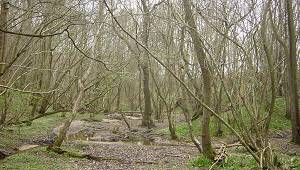Summary

The less intensive management of native woodlands reduces the effects of forestry practices such as drainage that act to increase peak flows. Thus it is argued that native woodlands are better placed to reduce downstream flooding. However, the lower water use of broadleaves, especially during winter, limits the scope for reducing peak flows.
Nevertheless, there is evidence from research work by CEH in Wales that the sponge effect alone could be responsible for a significant reduction in rapid runoff, compared to that from heavily grazed sheep pasture. Shallow compaction caused by sheep trampling can greatly reduce the ability of the soil to receive rainwater, potentially increasing the risk of flash floods. Research is underway by the Flood Research Consortium to evaluate and model this effect, both at the hill slope and catchment scale.
If soil compaction from grazing is found to contribute to increased flood flows, the planting of native woodlands could help to counter this, as well as provide a range of other benefits such as improved water quality.
